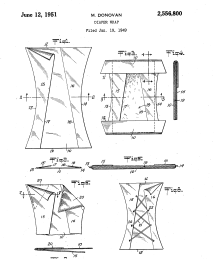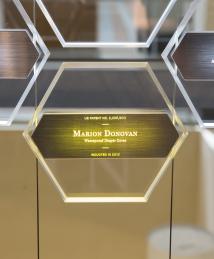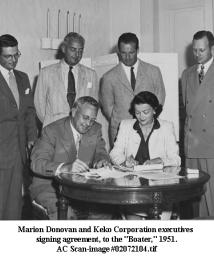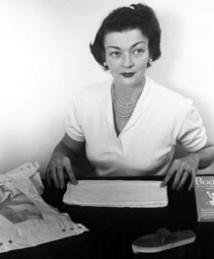Marion Donovan
Marion Donovan invented an innovative waterproof diaper cover and earned several more patents for inventions designed to improve everyday life.
Born Marion O’Brien in South Bend, Indiana, in 1917, she developed a passion for invention at a young age. Her father and uncle, Miles and John O’Brien, invented the “South Bend lathe,” a tool used to grind automobile gears, and Donovan spent much of her free time in their manufacturing plant, where she learned the basics of machinery and engineering. Her father even helped her produce her very first invention, a tooth powder, when she was a child.
Donovan attended Rosemont College in Philadelphia, graduating with a bachelor’s degree in English literature in 1939. Following her graduation, she moved to New York City, where she accepted a position as a beauty editor for Vogue magazine. Some years later, she resigned from her position and focused on raising a family in Westport, Connecticut. Soon, one of the everyday challenges she faced as a parent would serve as inspiration for a lifetime of invention.
Frustrated by the repetitive tasks of changing her daughter’s cloth diapers, clothing and bedsheets, Donovan wondered if she could create a more practical solution for preventing diaper leaks. Using material from a shower curtain, she cut and sewed pieces into a waterproof diaper cover. Improving upon this initial idea, she then created a diaper cover made with parachute cloth.
Unlike the rubber pants used for diapering at the time, Donovan’s invention did not pinch the skin or cause irritation. Her diaper cover allowed the skin to breathe, preventing diaper rash. Additionally, her design included an insert for an absorbent diaper panel and used snap fasteners instead of safety pins. She called this design the “Boater” because she believed it looked like a boat.
Though Donovan’s ingenious product presented clear advantages over existing designs, when she attempted to sell it to top manufacturers, it was rejected. In a 1975 interview, Donovan said, “I went to all the big names you can think of, and they said, ‘We don’t want it. No woman has asked us for that. They’re very happy, and they buy all our baby pants.’ So, I went into manufacturing myself.”
As New York’s Saks Fifth Avenue began selling Donovan’s Boaters in 1949, they became an instant success. After she received her first patent in 1951, she sold her company and the rights to Keko Corp. for $1 million. By that time, Donovan was developing a new idea beyond her waterproof cloth diaper covers: a disposable diaper that used absorbent paper.
Donovan’s new disposable diapers were initially ignored by executives, and it wasn’t until an entire decade later that Pampers® began mass-producing such a product. Today, it’s estimated that 95% of babies in the U.S. wear disposable diapers.
With the remarkable success of her Boaters, Donovan returned to school to study architecture at Yale University. “I always wanted to be an architect,” she said. “I’m fascinated by structure.” When she graduated in 1958, she was one of just three women in her graduating class. She subsequently designed her own home in Greenwich, Connecticut, in 1980.
Continuously inventing throughout her life, Donovan patented several more products. These included a 30-garment compact hanger; a soap dish that drained into the sink; a helpful elastic cord that connected over the shoulder to the zipper of a dress; and the DentaLoop, a flossing product that, like her waterproof diaper covers, she also chose to make and market herself.
Proving that domestic settings can be spaces for innovation, Donovan’s home often served as her lab and household items were her materials. She recognized common challenges in her life and used that understanding to innovate better solutions for others. Discussing her mother’s inspiring point of view, Donovan’s eldest daughter, Christine Donovan, recalled, “One thing that was fantastic about her: Running into an obstacle made her approach the idea in a new way. Her philosophy was, keep thinking and working to improve.”



